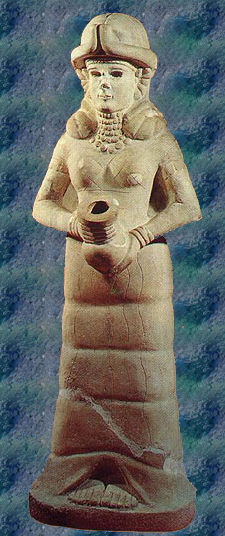The Paleo-Babylonian River-Statues and the fermentation vat (2rd millenium BC).
Another theme highlighting the beer in its relations with the rituals of fertility refers to the statues-symbol of the land fertility. Several statues or representations of statues as symbol of abundance has been discovered in Mesopotamia (to-day Iraq). A standing female deity holds in her hands a vase from which streams are flowing out, which one visualizes as waves on the surface of her dress. Several royal inscriptions, glorifying the generosity of sovereign, have described few copper statues representing a statue-river holding a vase.
One of these belongs to Warad-Sîn, king of Larsa between 1834 and 1823 BC :
"When the god Nanna his Lord was favorable to his prayers and supplications, he placed seven statues of river in copper with vats of abundance in copper in their hands. On the day of the ceremony of offerings, beer, wine and emmer-beer ... " [1].
The kind of offerings, all of them fermented beverages and particularly the beer, clearly refers to the liquid element and the beer of the agrarian rituals seen before.
In the text, these vases of abundance are called ní?-dúr-bùr (Akkadian namzitu), a Sumerian technical term primarily refering to the fermentation vat used by a brewer. This is first justified by a technical device : the bottom of the fermentation vessel is provided with a hole which allows the beer, once fermented, to flow out of the fermenting vat like the water from vases held by the statues. There are also heavy symbolic reasons to support a strong link between a fermentation vat and a vase of abundance. What object embodies a fertile country better than one overflowing jar of beer? Beer is the desired fruit of rich harvests of grain. This brewing vat, put appart the mystery enclosed inside it during the fermentation, can generate actual flows from the tangible wealth stored in granaries, namely the beer.
In the palace of Mari (present-day Syria) was discovered a river-statue with a pipe to the base, itself connected to the upper vessel with a hole[2]. It is not absolutely certain that these statues hold a fermenting vat because ní?-dúr-bùr means literally "vase-with-hole-at-bottom". However, the flow from a perforated vessel symbolizes abundance and fertility for the Mesopotamian inhabitants.
The city of Mari, although built on the banks of Middle Euphrates, lived under the strong cultural influence of the Akkadian southern Mesopotamia, at least the leaders who lived in the palace of Mari where the "river-statue" has been found. The description of the river-statues reminds the facade of the Karaindaš temple in ancient Uruk (southern present-day Iraq), decorated with sculptures bearing overflowing vases supplied with liquid through their bottom.
[1] Richard Ellis 1977, Mountains and Rivers, Bibliotheca Mesopotamica 7 : pp 30, 33-34.
[2] André Parrot 1959 : Le Palais : documents et monuments MAM 2/3, pp. 8-9. The operating instructions differs. For the fermentation vessel, the basal hole makes the beer flow downward by gravity. In the case of the abundance vessel, a perforation at the bottom of the jar fits a supplying conduit, a mean for producing a spouting effect of fluid (water) upward.



